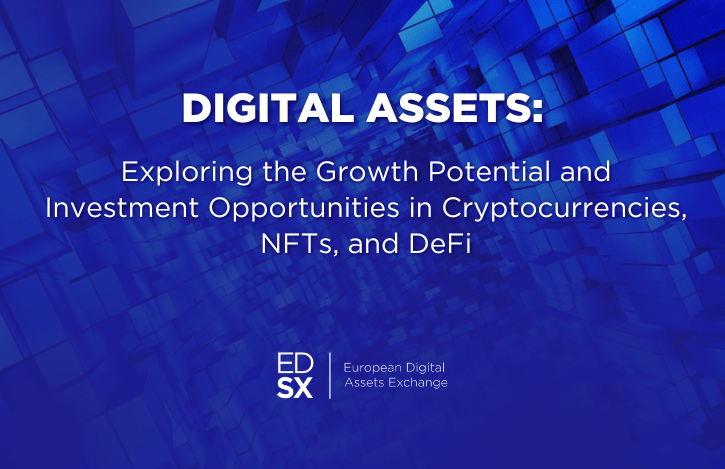Digital assets, including cryptocurrencies, non-fungible tokens (NFTs), and decentralized finance (DeFi), have captured the attention of high-net-worth individuals (HNWIs) and family offices (FOs) seeking new avenues for wealth growth. Despite recent market volatility, a joint report by Aspen Digital and KPMG China reveals that 92 percent of surveyed FOs and HNWIs in Hong Kong and Singapore are interested in digital wealth management. Namely, they are interested in digital assets. This article aims to explain why these investors are gravitating towards this emerging asset class. It also examines the growth potential that this new set of investment assets can be beneficial for new investors.
Unleashing the Upside Potential
Despite its emergence around a decade ago, digital assets have witnessed one of the fastest maturing periods of any market that has previously existed. There are many drivers for this beyond the high outsized returns, wholly outperforming traditional markets, such as stocks and gold. One of the factors is the fast and high amount of development in terms of infrastructure and talent acquisition. This demand for high quality talent is expected to continue, which will further impact the development of the sector. The demand for high-quality talent from service providers has skyrocketed, leading to job postings related to digital assets growing by nearly 400 percent in 2021. This surge in talent and infrastructure development enhances the long-term sustainability and growth potential of the sector.
All of this development and maturity has led to heightened interest of institutional investors who are publicly investing in digital assets, which have given Fos and HNWIs more confidence about the sector as a whole. Notably, public announcements of major companies investing in Bitcoin and Ethereum have contributed to this growing institutional attention. Nevertheless, caution is advised due to the market’s high volatility. It is crucial to do thorough research and conduct a robust risk management strategy.
Navigating Regulatory Challenges
Despite the overall confidence in the digital asset market, FOs and HNWIs still harbor uncertainties regarding investing in this space. Regulatory and valuation concerns remain key factors contributing to this uncertainty. Investors seek a clear and favorable regulatory framework that can effectively govern digital asset trading, considering the divergent approaches to regulation observed across jurisdictions. Digital wealth management services that provide clarity and guidance on regulations can help address some of these investor uncertainties.
Nevertheless, regulatory bodies worldwide are actively establishing specific regimes tailored to address the unique characteristics of digital assets. Notable examples include Hong Kong’s mandate for all virtual asset service providers (VASPs) to secure licenses by March 2024, as well as Singapore’s plans to expand its cryptocurrency regulations. Moreover, the European Union (EU) has introduced initiatives such as the Pilot Regime and the Markets in Crypto-Assets Regulation (MiCA), demonstrating their commitment to developing comprehensive regulatory frameworks for digital assets. As regulatory clarity increases, digital wealth management may become a more attractive option for sophisticated investors.
Valuing digital assets remains a significant concern for many investors. The limited availability of publicly accessible information makes accurate valuation a challenging task. More than 50% of HNWIs investing in digital assets have raised concerns about this issue. Furthermore, the lack of research and standardized valuation methodologies, coupled with the uncertainties surrounding tax treatment, can potentially lead to disputes with tax authorities. Despite these uncertainties, investors find confidence in their digital asset investments due to the availability of real-time data for evaluating asset performance, while ongoing regulatory developments aim to reduce uncertainties related to taxation. Digital wealth managers can help navigate the complexities of valuation and tax treatment of digital assets.
Investors are also concerned about financial reporting requirements for investment-held digital assets. The challenge lies not so much in the clarity of necessary accounting practices but rather in the discrepancy between these requirements and the specific needs of investors. The market volatility witnessed in recent years has influenced investment strategies,. This lead overall respondents to adopt market-neutral approaches and invest in stablecoins. Investing in digital wealth management service providers offers FOs and HNWIs a means to participate in the anticipated growth of the digital asset sector while mitigating the impact of value fluctuations.
Digital Assets as an Emerging Asset Class
The digital asset sector has experienced remarkable growth, currently boasting a market capitalization surpassing $1 trillion USD. It has established itself as a viable asset class, garnering attention from wealth managers and their clients. Recent research indicates that nearly 60% of FOs and HNWIs are already investing in digital assets, while the remaining 40% express interest in doing so. The enticing prospect of significant returns has drawn the attention of sophisticated investors. This underscores the wealth creation potential associated with this asset class.
Notwithstanding the acceptance and interest, caution prevails among investors when it comes to digital asset instruments. Most investors allocate a maximum of 5% of their portfolio to this asset class. While approximately 50% of investors express a desire to increase their allocation to digital assets, they do so gradually and with measured steps. Regulatory uncertainties and high volatility act as limiting factors, constraining rapid growth in allocation. Cryptocurrencies like Bitcoin and Ethereum are the most popular investment choices. Emerging areas, specifically NFTs, DeFi, and STOs, are garnering increasing interest.
It is important to note that while investors recognize the potential of the digital asset sector, they approach it with a tempered perspective. Investors cautiously allocate resources to this asset class, taking into consideration the evolving regulatory landscape and the inherent volatility associated with digital assets. This measured approach allows investors to mitigate risks while exploring the opportunities for wealth accumulation in this rapidly evolving market.
Exploring the Metaverse and DeFi
Investors are increasingly diversifying their digital asset portfolios by holding Bitcoin and Ethereum, according to a recent study. This trend is indicative of the growing mainstream attention and significant growth potential observed in these sectors. Furthermore, investors are expressing a keen interest in exploring decentralized finance (DeFi) and metaverse-related tokens. This highlights their recognition of the disruptive potential in these areas. Ethereum’s scalability and ecosystem development, following its blockchain upgrade, have particularly attracted bullish sentiment among investors.
To further expand their allocation to digital assets, investors are seeking hedging and derivative products that go beyond the popular Bitcoin and Ethereum tokens. The availability of such products for a wider range of digital assets will drive increased investment.
The emergence of decentralized finance (DeFi) has captured institutional attention due to its ability to revolutionize the financial services industry. DeFi enables financial services through public blockchains and smart contracts, eliminating the need for centralized intervention. The DeFi market has experienced substantial growth, with a total value locked of approximately $55.4 billion as of September 2022. Despite recent market volatility, the number of unique addresses transacting DeFi assets has remained stable. Investors recognize DeFi as a top area of interest, acknowledging its potential to reshape financial markets.
Institutional interest is also growing in non-fungible tokens (NFTs) and the metaverse. The metaverse, estimated to present a $13 trillion market opportunity, is projected to attract billions of users by 2030. Currently, investors are allocating a median of 8% of their digital asset portfolios to NFTs and metaverse-related tokens. Enhanced token utility, price transparency, and regulation catalyze the mass adoption of NFTs.
Looking Ahead
The rise of digital assets presents a transformative shift in the investment landscape, offering promising prospects for strategic participants. As regulatory frameworks continue to evolve and address concerns surrounding digital asset trading, institutional interest and confidence among high-net-worth individuals and family offices are expected to grow. The gradual increase in digital wealth management demonstrates the recognition of their potential for significant returns. Moreover, the exploration of emerging areas such as the metaverse and DeFi highlights their disruptive power in reshaping financial markets.
With the development of hedging and derivative products for a wider range of digital assets, investment growth will be further fueled. Enhanced token utility, price transparency, and ongoing regulatory advancements will contribute to the mass adoption of non-fungible tokens (NFTs). While caution prevails, investors are poised to navigate the risks and seize opportunities in this rapidly evolving market. Therefore, they blaze the trail where digital assets play an integral role in wealth and investment strategies.

Based in Zug, the platform is fully compliant with all Swiss laws related to financial intermediaries, banking, anti-money laundering, and organized trading facilities. Among its core values, there are innovative solutions through blockchain technology, which ensures security and liquidity.
EDSX is the first platform in Europe with primary and secondary markets for both institutional and retails. EDSX is a pioneering platform that employs the world’s leading technology to globally list security tokens in both primary and secondary markets, listing digital securities of real financial instruments to the public with a decentralized peer-to-peer exchange. Our goal is to fully engage every aspect of the financial revolution.
Do you have a question for us?
Send your query here:
[email protected]

